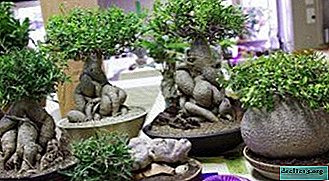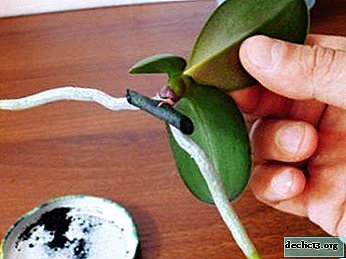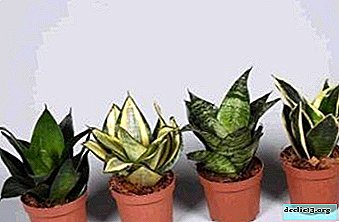Amazing fokey: description, types, care, disease and reproduction

Recently, among plant lovers, succulents have become popular. Not too whimsical, resistant to drought, pleasing to the eye with its beauty - they quickly earned the love of people.
One of these plants is fokey. What are the types and varieties of this plant, about the rules of care, diseases and pests, as well as how to propagate this amazing flower - more about this in our article.
Description
Fokey (Fockea) is a genus of plants of the Lastovnev family, which combines more than 10 species of plants growing in South Africa, Namibia, Botswana and Zimbabwe. In natural conditions, its branches reach 4 meters, but in indoor plants it grows much more modestly - only up to 0.5 meters. Oval, with a slight pointedness on the top of the leaf, are attached to the branches with short petioles. The lower part of the trunk lignifies over time, forming a caudex.
It grows rapidly in young plants, especially if you place them in a large pot. With age, the growth of the root thickening of the succulent is becoming slower, and then it can stop.The earliest references to these plants date back to the beginning of the 19th century. But there are sources that claim that the fokey was discovered even earlier, since a similar sample of the plant was delivered to the court of the emperor of Austria to decorate the garden with this exotic. But they named succulent in honor of the famous physiologist and doctor - Gustav Voldemar Fock.
Popular types and varieties of Fockea
Edulis

Also known as Edible Fokey, Hottentot bread, and Afrikaans people call it Berbaro, Bergkambra, Kambara, Cambra, Cambro or Hotnotvaatlemoen. Its root is edible and has a slightly sweet milky flavor. Phokea edulis is a perennial plant with a small amount of foliage. The large roots and base of the trunk have twisted outlines.
Under natural conditions, the caudex is buried in the soil and grows rapidly, reaching 60 cm across. The plant is dioecious, so for reproduction it is necessary that the foci of different sexes are nearby. The flowers are whitish-green, in the shape of an asterisk, exude a light pleasant aroma. On one peduncle there may be several flowers. Petals are surrounded by a large cup. After flowering, grayish-green seed pods are formed.
The video shows in detail Fokey Edulis:
Multiflora

Also called Pinion Vine / Vine. This is a large succulent vine with shoots that can reach up to 15 meters. Caudex contains a large amount of poisonous milky juice. The seeds, fruits and leaves of Phokea multiflora are much larger than other plants of this genus. Flowering is possible even in the absence of foliage. Flowers with five petals have a yellow-green hue. Fruits are horn-shaped pods with a smooth surface, grow in pairs, open and release several winged seeds when they mature.
Curly (Crispa)

She Fokey Cape, is the most popular species. Thin creeping branches of the succulent lie on the surface of the soil, but can wrap some kind of support and grow upward, like vines. The elliptical-oval leaves of a deep green color are framed by curl. The back side of the leaf has a purple color. During flowering, the plant has slightly sympathetic star-shaped flowers of a greenish tint.
Capensis (Capensis)

Prefers rocky soil. Tuberous roots of succulents are often squeezed between the stones. The gray-green leaves of elliptical shape have small pubescence. The sheet is strongly folded on the sides. During flowering, star-shaped small flowers appear, with twisted flattened petals of a greenish tint. The fruit is a seed pod.
Home Care
- Temperature. In summer, up to 35 ° C, in winter, if kept alone, a temperature of 12-13 ° C is desirable, the minimum is 5 ° C.
Important! The plant tolerates short-term frosts, but then the fokey should be hardly watered.
- Watering. In spring and summer, fokeya is actively growing, at which time it should be abundantly watered as the top layer of soil dries. In winter, you can limit yourself to one watering per month. If the caudex has become soft, it is time to water the plant. During irrigation, it is necessary to ensure that water does not fall on the caudex.
- Lighting. Fokey prefers bright, intense light. But all caudex plants have one feature - overheating is dangerous for caudex. It should be blocked by a screen until the fokey grows sufficiently so that the leaves and shoots cover the caudex.
- Priming. Loose soil for succulents with a small addition of sand is perfect. For a home-made mixture, you need to take: 3 parts of coarse sand or perlite, 2 parts of garden soil, 2 parts of humus, 1 part of charcoal and bone meal, lime or a small amount of eggshell. Good drainage is needed.
- Pruning. In nature, the whole aerial part of the fokey dies in dry periods, but this does not happen at home, and the fokey can continue to lengthen the shoots. Trimming can hold back growth. The plant easily tolerates pruning and quickly recovers after it. If the stems or caudex foci are damaged, poisonous milky juice will stand out from them. When working with the plant should take care of your hands.
- Top dressing. To make the caudex grow voluminous and decorative, use nitrogen, liquid top dressing. From March to August, succulent must be fed every 2-3 weeks, fertilizer for cacti.
- Pot. Fokey needs a large pot due to the fact that its root system has the ability to grow rapidly. If the pot is not large enough, it may even crack.
- Transfer. The root system of phokei is well developed and is growing rapidly. Every year, in the spring, a transplant is required in a large pot. When transplanting young plants, the caudex is left at the same level. In old ones, the caudex is gradually raised above the soil. From the first transplants, it is important to establish a support in the pot and make sure that the shoots rise only along it.Advice! If you want to get an impressive copy of fokey, then you need to do regular transhipments during the period of active growth.
- Wintering. Fokey needs a period of winter rest. If during the winter the succulent is in a cold temperature and dry, all the leaves may fall, and the plant will go into a dormant state. If you keep the plant warm, the growing season can last year round. With excessive watering in winter, root rot is possible.
Breeding
- Propagation by cuttings is practically impracticable. Even if they manage to be rooted, they cannot form a caudex.
- Propagation by seed.
If the planting material is stale, it must be soaked. If the seeds are recently harvested, then you can immediately begin to plant.
- The vessel is filled with a substrate of peat, river sand and perlite (in equal proportions), moisturized and buried seeds in it.
- The container with crops is placed in a warm place with good lighting, but away from direct sunlight.
- You can place a piece of glass on top, or wrap the container in a transparent plastic bag.
Using such protection, you will need to clean it daily for 10-15 minutes so that the crops are ventilated.
If everything is done according to the rules, then the seedlings will appear in 7-14 days and will instantly begin to "inflate" their bases. In open ground, fokey is not grown.
Bloom
Phokea begins to bloom towards the end of summer. Small flowers are inconspicuous and unsightly, in shape resemble a five-pointed star. Flowering lasts about 2 months. Pruning does not affect flowering. If the fokey does not bloom, you can try to pollinate it artificially, but this is a very difficult task, which often does not bring success.
Diseases and Pests
Fokey has few of them:
- It is mainly affected by whiteflies, aphids and spider mites. The plant should be inspected periodically for pests.
- Fokey can also affect fungal diseases.
Similar plants
- Petopentia natalensis (Petopentia natalensis), which used to belong to the genus Fockea, and now belongs to the genus Petopentia.
- Ficus microcarpa (Ficus micrpcarpa) - A typical caudex plant from the genus Ficus.
- Brachychiton - A special genus of Australian caudex plants. Belongs to the family Malvaceae.
- Kedrostis African (Kedrostis africana) - A species from the genus Kedrostis, characterized by a huge caudex.
- Phyllanthus the Amazing (Phyllanthus mirabilis) is the only species of the genus Phillanthus that forms caudex.
Fokeya is a plant that, despite its somewhat strange appearance, looks very original. It is worth noting the beautiful bark and texture of the caudex. Fokey unpretentious and will perfectly complement the room.

















